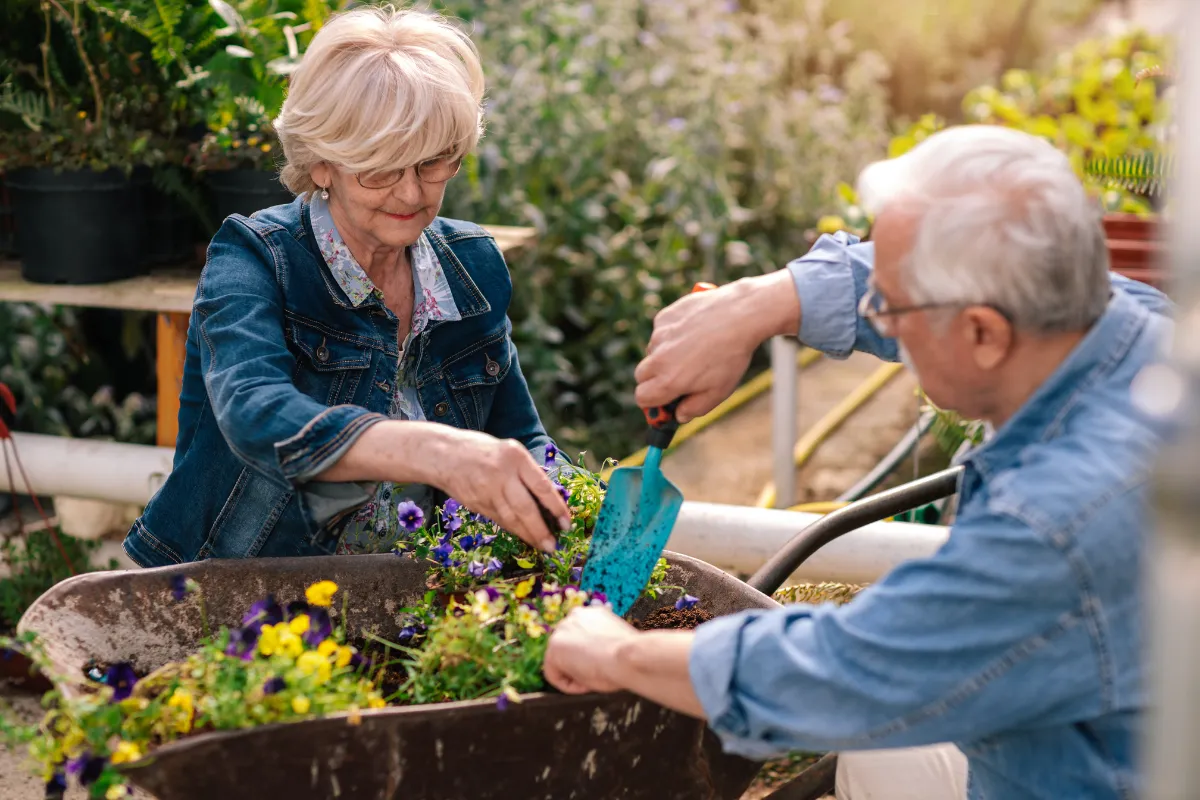Is your back pain making gardening difficult?
There are many reasons why your back might hurt when you garden. Poor posture, not warming up, or lifting items incorrectly are just a few of them.
It might not seem like it, but gardening can be hard on your body, and bending over for long periods at a time can cause or worsen back pain that you might already have. Fortunately, with some stretching, extra support, and a few adjustments, you can keep both your back and your garden in good shape.
Gardening is not only relaxing and enjoyable, but it also comes with the satisfaction of growing your own produce or flowers. And on top of that, a beautiful garden can create the perfect setting for sharing good times with your friends and family.
Whether you have chronic back pain or are looking to prevent injuries, read on to find out how you can minimize back pain and get back to doing what you love.
7 Tips To Help You Prevent Back Pain When You Garden
Stretch and warm up before you get started
Before getting started, it’s important to warm up your body with a short walk or some stretches. Warming up your body can help you to have a more pleasant gardening experience and also prevent strains and injuries.
Not sure which stretches to do? One of our physical therapists can help you to find the best stretches for your back pain.
Be mindful of your position and movements
Back pain is often caused by poor posture. While going through your tasks, take your time and avoid any sudden movements.
As you bend down, try to maintain your spine’s natural curve to avoid straining it. When kneeling, keep one knee on the ground and one up, and switch whenever you need to.
Lift heavy items with caution
To safely lift heavy objects, start by squatting instead of bending at your waist. Take hold of the object with both hands, hold it close to your body, and then straighten up your legs slowly.
If you often have heavy items to move or carry, consider getting a wheelbarrow or asking someone to help you.
Don’t overwork yourself and take plenty of breaks
Time flies when you’re out in the garden, doesn’t it? Remember to stretch after being in the same position for a long time or performing repetitive tasks. Alternate between tasks and reposition yourself often to avoid injuries caused by repetitive motions.
Rather than taking on a big garden project all in one go, split up the work over a few days. Besides putting less strain on the same part of your back for hours at a time, mixing up the jobs will also ultimately make them easier to accomplish.
Pay attention to your body and don’t ignore pain signals! The best thing to do if you are in pain is to take a break or finish up for the day.
Get support from tools
With the appropriate tools, gardening can be easier, more relaxing, and less painful on your back.
- Kneelers and chairs: Kneelers with cushioned handles help you to get up and down with less effort, while also letting you work your arm muscles a bit.
- Use the right tools: When kneeling down to weed, use short-handled gardening tools to avoid overstretching and straining yourself. For reaching branches from the ground, it’s better to use long-handled tools.
- Knee pads: If you prefer kneeling on the ground and want to avoid putting excess pressure on your back, add some extra cushioning with knee pads.
- Garden scooters: These wheeled scooters can help minimize twisting, which can take a toll on your joints and spinal discs.
Rethink the way you garden
Gardening at a higher level might be a good solution if you’re experiencing back pain.
-
- Container gardening: This method of growing plants in large containers is perfect for flowers and vegetables.
- Vertical gardening: With this style, also known as wall gardening, plants are grown vertically. It’s much easier on your back as you can work while standing up.
- Raised-bed gardening: Let the plants come to you! An extremely versatile approach, this type of gardening uses raised beds between 2 to 3 feet tall.
- Balcony gardening: Attaching balcony planters to your balcony lets you grow your favorite flowers or herbs for cooking.
Make sure you stretch afterward, too!
Don’t forget to stretch after! The reason for this is that stretching can help to minimize inflammation and, therefore, help prevent pain. Using a hot or cold compress is also great. Alternatively, you can use a bag of frozen vegetables or a hot water bottle.
Do You Want To Treat Back Pain Without Drugs And Surgery?
Understanding your pain is the first step to relief. At the Illinois Back Institute, we’re dedicated to spreading knowledge about back pain and sciatica, because we know that making people aware of their condition improves their chances of recovery!
Let’s get you back to a healthy, pain-free life. Our experienced team of practiced doctors, chiropractors, physical therapists, and nurse practitioners use a proven method that has helped over 500,000 patients.
Get started with a free consultation today! Fill out the form below or call us at (833) 215-7894 to schedule your free consultation.


